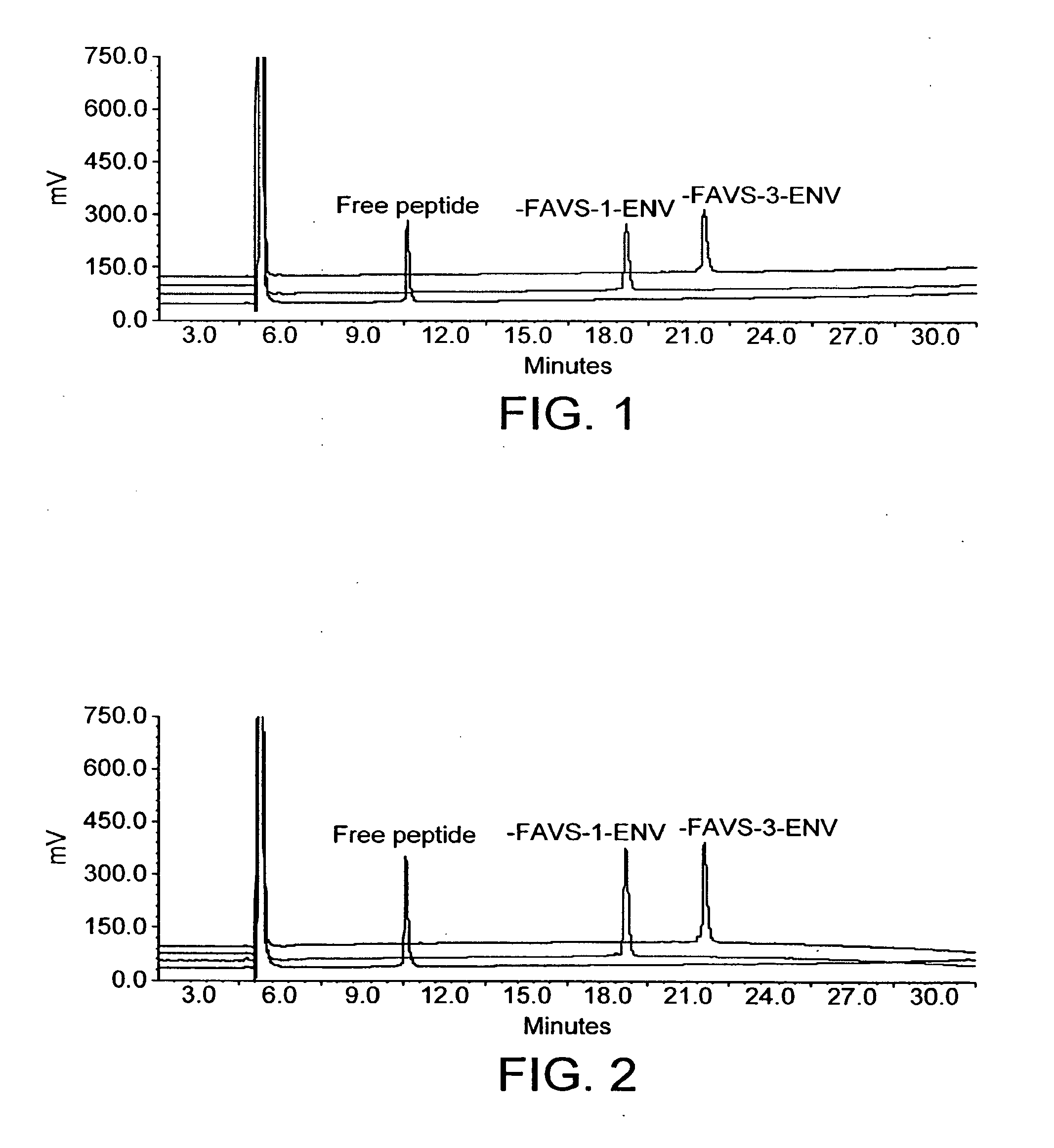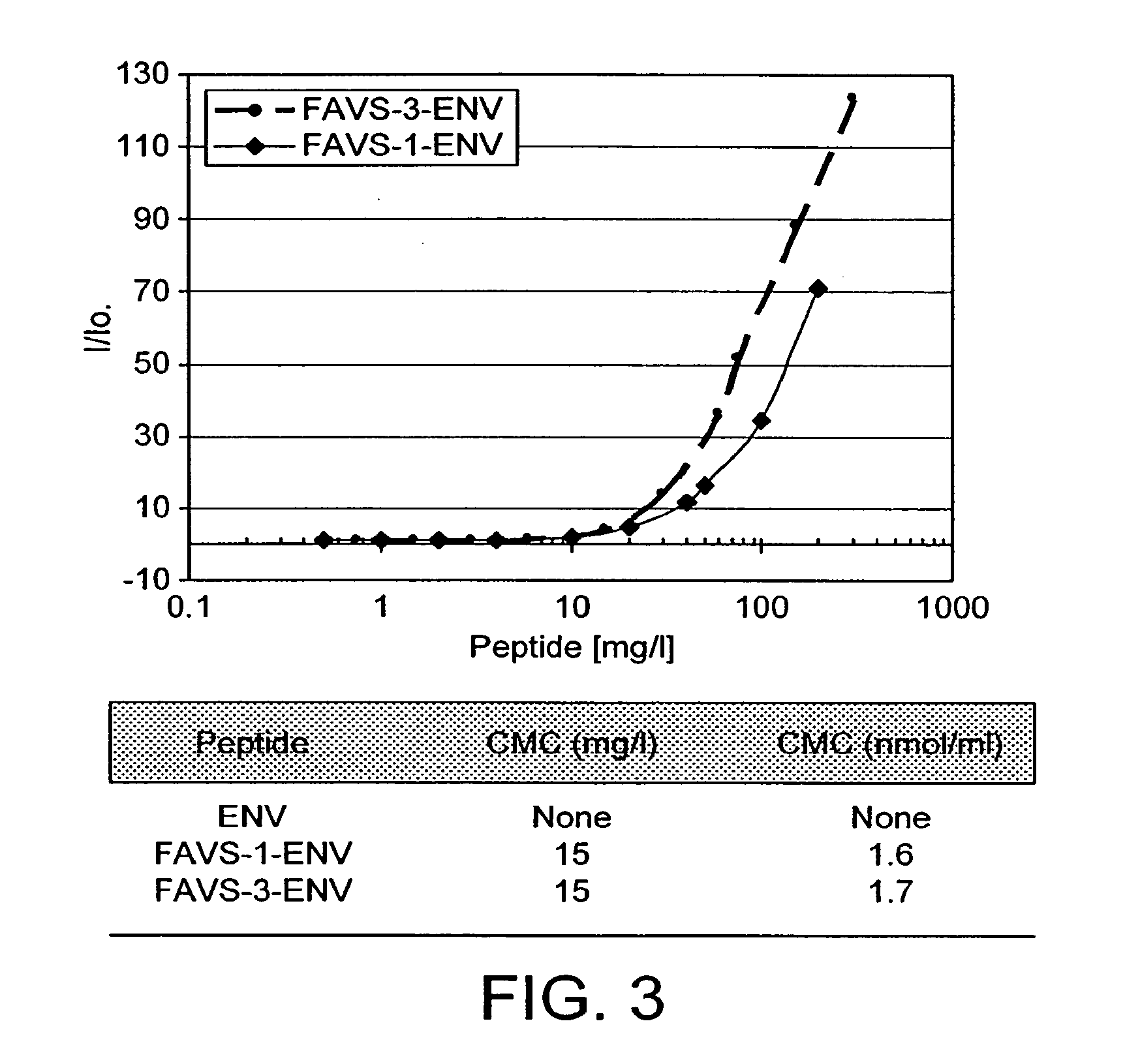Antigen Delivery Vectors and Constructs
a delivery vector and antigen technology, applied in the field of new antigen delivery constructs, can solve the problems of ineffective innate immune response, inability to achieve safe and effective vaccines for the prevention and treatment of human immunodeficiency virus (hiv) infection, and inability to meet the needs of patients, etc., to achieve optimised steric presentation of antigen, improve stability and/or solubility, and enhance immunogenicity of administered antigens
- Summary
- Abstract
- Description
- Claims
- Application Information
AI Technical Summary
Benefits of technology
Problems solved by technology
Method used
Image
Examples
example 1
Synthesis of Fluorocarbon-Vectored Peptides
[0048]The following fluorocarbon-vector peptides were synthesised:
FAVS-1-ENV:NNTRKRIRIQRGPGRAFVTIGK-C8F17(CH2)2CO-K-NH2FAVS-2-ENV:NNTRKRIRIQRGPGRAFVTIGK-C8F17(CH2)6CO-K-NH2FAVS-3-ENV:IRIQRGPGRAFVTIGKK-CO(CH2)2-(PEG)4-C8F17(CH2)6CO-K-NH2
[0049]Where the standard amino acid one letter code is utilised and PEG is CH2—CH2—O, NNTRKRIRIQRGPGRAFVTIGK is the EN-(301-322) peptide of the Human Immunodeficiency Virus.
[0050]Peptide synthesis was carried out on an ABI 430 or ABI 433 automatic peptide synthesizer, on Rink amide resin (0.38 mmol / g loading) using Nsc (2-(4-nitrophenylsulfonyl)ethoxycarbonyl), or Fmoc ((9-fluorenylmethylcarbonyl) amino acids. Coupling was promoted with HOCt (6-Chloro-1-oxybenzotriazole) and DIC (1,3-diisopropylcarbodiimide), and Fmoc / Nsc deprotection was carried out using 20% piperidine in DMF (Dimethylformamide). Uncoupled N-termini were capped with acetic anhydride as part of each cycle. Cleavage of the peptide from resin ...
example 2
Physicochemical Analysis of Fluorocarbon-Vectored Peptides
(i) Solubility
[0054]The solubility of the fluorocarbon-vector peptides in aqueous solution at concentrations useful for a pharmaceutical formulation was confirmed. Solutions of peptides were prepared at 20° C. by dissolving the lyophilised peptide powder with PBS (0.01M, pH 7.2) across a range of concentrations. Preparations were then vortexed for one minute. An aliquot was collected and the remainder of the solution was centrifuged for 10 minutes at 12,000 rpm. To a 96-well flat bottom plate containing 25 μl aliquots of serial dilutions of each peptide was added 200 μl of the BCA working reagent (Pierce, UK) containing the solution A (bicichoninic acid, sodium carbonate, sodium tartrate in a sodium hydroxyde 0.1M solution, 50 vol,) and B (4% cupric sulphate solution, 1 vol.). After incubating for 45 minutes at 37° C. and cooling for 10 minutes, the absorbance was measured at 570 nm. The plates were analysed by a Wallac Victo...
example 3
(i) Immunogenicity of Fluorocarbon-Vectored Peptides
[0057]Specific-pathogen-free mice (6-8 week female Balb / c) were purchased from Harlan (UK). Peptides ENV, FAVS-1-ENV, FAVS-2-ENV or FAVS-3-ENV were dissolved in PBS (0.01M, pH 7.2). Each dose was normalised to 50 nmol peptide per ml based on the net peptide content obtained from amino-acid analysis. Mice (3 per group) were immunized subcutaneously under the skin of the interscapular area with 50 nmol peptide in a volume of 100 μl PBS, pH 7.2. Three doses were administered at ten day intervals. A mouse group receiving a priming dose of free peptide admixed with Complete Freund's adjuvant (50 nmol peptide in PBS emulsified in an equal volume of adjuvant) and booster doses of Incomplete Freund's adjuvant served as a positive control. Ten days after the final immunisation mice were sacrificed and spleens removed to assess the cellular immune response to the peptide. To determine the progress of the immune response development, groups o...
PUM
 Login to View More
Login to View More Abstract
Description
Claims
Application Information
 Login to View More
Login to View More - R&D
- Intellectual Property
- Life Sciences
- Materials
- Tech Scout
- Unparalleled Data Quality
- Higher Quality Content
- 60% Fewer Hallucinations
Browse by: Latest US Patents, China's latest patents, Technical Efficacy Thesaurus, Application Domain, Technology Topic, Popular Technical Reports.
© 2025 PatSnap. All rights reserved.Legal|Privacy policy|Modern Slavery Act Transparency Statement|Sitemap|About US| Contact US: help@patsnap.com



